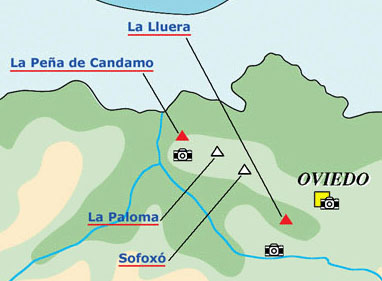Photo Archives: Paleolithic Art in Northern Spain
La Peña de Candamo
Preview Edition
- 20 photos(about1280x1000/JPEG) and the 4 variations(about1470x980/JPEG).
- Commentary by César González Sainz & Roberto Cacho Toca, Univ. of Cantabria.
- Royality Free for private and educational use.
In this downloadable photo archives are contained 20 photos and the 4 variations of Paleolithic cave art of Peña de Candamo cave with the archeological data and commentary as shown in this preview pages. Only the small sized reference images and a part of commentary are shown in this preview edition, but if you are interested to see more and to use these photos, please go to Kagi store and purchase the data package. Once payment has been made at the Kagi store, you will receive an e-mail containing the URL to download the data package. All photos that are contained in this package are ROYALITY FREE for private and educational use.
 Peña de Candamo
Peña de Candamo
The cave art in Cueva de La Peña de Candamo, in the village of San Román de Candamo, is the westernmost assemblage in the whole of the long corridor forming the Cantabrian region. Its position therefore marks the end of the area of limestone hills and well-developed karst landforms. The entrance of the cave is on the right-hand bank of the Nalón river but, whereas the other cave art sites in the middle valley are just above the present-day river course, this cave is located at the top of a steep hillside, called "Pena de Candamo", 200m above sea level. In this way, the entrance overlooks a wide area, and several natural communication routes, such as the access to the middle valley of the River Nalón. The great strategic value of the location has, in consequence, often been stressed, as it could have been used to control the animal herds moving along the valley and, perhaps, human groups too.
The cave was studied in 1914 by E. Hernández Pacheco, assisted by J. Cabréand Benitez Mellado, who carried out a magnificent work of documentation and analysis of its art. No artifacts or other remains of human occupation were found in the cave, but they were in another small cave near-by. This had a single, thick layer, with abundant industry of Solutrean age (21,000-16,500 BP), probably belonging to periodic human occupation of the site.
The cave is short, and generally rather small, but despite that, it is quite spectacular. It has many large calcite formations, like columns, flowstone and gour floors, which noticeably conditioned the organization of the art, especially regarding the choice of panels and even the techniques applied in the Upper Paleolithic. In fact, this profusion of calcite limited the production of art to a few accessible, clean walls, in three or four different locations. Besides, the growth of the flowstone separated a few small high-level chambers, like the so-called "Camerin". In this space, after climbing a stalagmitic flowstone, Paleolithic people drew animal depictions visible from all points of the main central chamber in the interior of the cave.
---------------
[References]
Hernández Pacheco, E. 1919. La caverna de la Peña de Candamo (Asturias). CIPP, no. 24. Madrid.
Moure, J.A. 1981. Algunas consideraciones sobre el "Muro de los grabados" de San Román de Candamo (Asturias). Altamira Symposium (Madrid 1979), pp. 339-352. Madrid.
|
Photographed by Takeo Fukazawa & Co-Project Team of Texnai Inc. and the University of Cantabria
Commentary by César González Sainz & Roberto Cacho Toca, Univ. of Cantabria
Texnai Inc.:
2-1, Udagawa-cho, Shibuya-ku, Tokyo, Japan. Tel:03-3464-6927 Fax:03-3476-2372
e-mail:info@texnai.co.jp
Copyright reserved by Takeo Fukazawa &Texnai, Inc., University of Cantabria, IPA
|
|